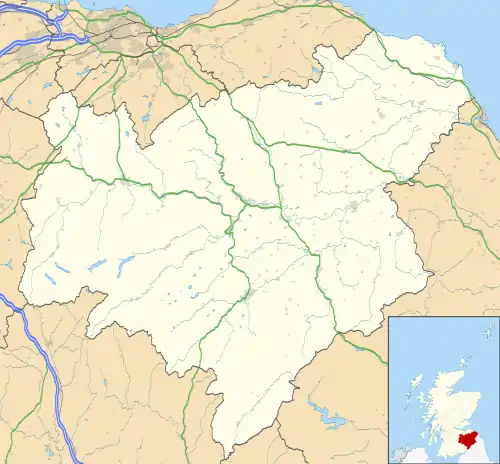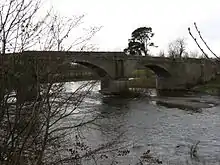Kelso, Scottish Borders
Kelso (Scots: Kelsae,[2] Scottish Gaelic: Cealsaidh[3]) is a market town in the Scottish Borders area of Scotland. Within the boundaries of the historic county of Roxburghshire, it lies where the rivers Tweed and Teviot have their confluence. The town has a population of 5,639 according to the 2011 census and based on the 2010 definition of the locality.[4]
Kelso
| |
|---|---|
 Kelso seen from the Cobby Tweedside meadow | |
 Kelso Location within the Scottish Borders | |
| Population | 6,910 (mid-2016 est.)[1] |
| OS grid reference | NT7268233961 |
| • Edinburgh | 44 mi (71 km) |
| • London | 350 mi (560 km) |
| Council area | |
| Lieutenancy area | |
| Country | Scotland |
| Sovereign state | United Kingdom |
| Post town | KELSO |
| Postcode district | TD5 |
| Dialling code | 01573 |
| Police | Scotland |
| Fire | Scottish |
| Ambulance | Scottish |
| UK Parliament | |
| Scottish Parliament | |
Kelso's main tourist draws are the ruined Kelso Abbey and Floors Castle, a William Adam designed house completed in 1726. The Kelso Bridge was designed by John Rennie who later built London Bridge.
Kelso is also notable for a long meteorological history. It held the UK record for lowest, official, January temperature at −26.7 °C (−16.1 °F), from 1881 until 1982.[5] It also held the December record with the same temperature from 1879 to 1995.[6] The current record low for the town is −27.0 °C (−16.6 °F) set in December 1995.[7]
History
The town of Kelso came into being as a direct result of the creation of Kelso Abbey in 1128. The town's name stems from the fact that the earliest settlement stood on a chalky outcrop, and the town was known as Calkou (or perhaps Calchfynydd) in those early days, something that is remembered in the modern street name, "Chalkheugh Terrace".[8]

Standing on the opposite bank of the River Tweed from the now-vanished royal burgh of Roxburgh, Kelso and its sister hamlet of Wester Kelso were linked to the burgh by a ferry at Wester Kelso. A small hamlet existed before the completion of the abbey in 1128 but the settlement started to flourish with the arrival of the monks. Many were skilled craftsmen, and they helped the local population as the village expanded. The abbey controlled much of life in Kelso-area burgh of barony, called Holydean, until the Reformation in the 16th century. After that, the power and wealth of the abbey declined. The Kerr family of Cessford took over the barony and many of the abbey's properties around the town. By the 17th century, they virtually owned Kelso.
In Roxburgh Street is the outline of a horseshoe petrosomatoglyph where the horse of Charles Edward Stuart cast a shoe as he was riding it through the town on his way to Carlisle in 1745. He is also said to have planted a white rosebush in his host's garden, descendants of which are still said to flourish in the area.[9]
For some period of time the Kelso parish was able to levy a tax of 2 pence (2d) on every Scottish pint of ale, beer or porter sold within the town.[10][11] The power to do this was extended for 21 years in 1802 under the Kelso Two Pennies Scots Act when the money was being used to replace a bridge across the River Tweed that had been destroyed by floods.[10]
The war memorial was erected in 1921 to a design by Sir Robert Lorimer.[12]
Community


Kelso High School provides secondary education to the town, and primary education is provided by Edenside Primary and Broomlands Primary.
The town has much sport and recreation, the River Tweed at Kelso is renowned for its salmon fishing, there are two eighteen-hole golf courses as well as a National Hunt (jumping) horse racing track, Kelso Racecourse is known as "Britain's Friendliest Racecourse", racing first took place in Kelso in 1822.
In 2005 the town hosted the 'World Meeting of Citroën 2CV Friends' in the grounds of nearby Floors Castle. Over 7,000 people took over the town and are said to have brought in more than £2 million to the local economy.
According to a letter dated 17 October 1788, 'The workmen now employed in digging the foundations of some religious houses which stood upon St. James' Green, where the great annual fair of that name is now held in the neighbourhood of this town, have dug up two sone [sic] coffins of which the bones were entire, several pieces of painted glass, a silver coin of Robert II, and other antique relics'.[13]
The town's rugby union club is Kelso RFC. The club holds an annual rugby sevens tournament takes place in early May. Former players include Ross Ford, the current record holder for men's senior caps with the Scotland men's rugby union team. Other former players include John Jeffrey, Roger Baird, Andrew Ker and Adam Roxburgh, who all featured in 7s teams that dominated the Borders circuit in the 1980s - including several wins in the blue ribbon event at Melrose. Kelso RFC also hold an annual rugby fixture; this fixture is the oldest unbroken fixture between a Scottish and Welsh side.
Every year in July, the town celebrates the border tradition of Common Riding, known as Kelso Civic Week. The festival lasts a full week and is headed by the Kelsae Laddie with his Right and Left Hand Men. The Laddie and his followers visit neighbouring villages on horseback with the climax being the Yetholm Ride on the Saturday. Kelso hosts its annual fair on the first weekend of September. The festivities include dancing, street entertainers, live music, stalls and a free concert. The fair attracts about 10,000 people to the town.
People
Sir Walter Scott attended Kelso Grammar School in 1783 and he said of the town, "it is the most beautiful if not the most romantic village in Scotland". Another attraction is the Cobby Riverside Walk which goes from the town centre to Floors Castle along the banks of the Tweed passing the point where it is joined by the River Teviot. Kelso has three bridges that span the River Tweed, "Rennie's Bridge" was completed in 1803 to replace an earlier one washed away in the floods of 1797, it was built by John Rennie of Haddington, who later went on to build Waterloo Bridge in London, his bridge in Kelso is a smaller and earlier version of Waterloo Bridge. The bridge was the cause of local rioting in 1854 when the Kelso population objected to paying tolls even when the cost of construction had been covered, the Riot Act was read, three years later tolls were abolished. Hunter's Bridge, a kilometre downstream, is a modern construction built to divert vehicles around the town and so take much of the heavy traffic that has damaged Rennie's bridge.
Famous people from Kelso have included the leading suffragette supporter Georgiana Solomon who was born here in 1844, the civil engineer Sir James Brunlees (1816–1892) who constructed many railways in the United Kingdom as well as designing the docks at Avonmouth and Whitehaven. Sir William Fairbairn (1789–1874) was another engineer who built the first iron hulled steamship the Lord Dundas and constructed over 1000 bridges using the tubular steel method which he pioneered. Thomas Pringle the writer, poet and abolitionist, was born at nearby Blakelaw, a 500-acre (2.0 km2) farmstead four miles (6 km) to the south of the town where his father was the tenant. Donald Farmer, a Victoria Cross recipient was born in Kelso, as was Ross Ford, who holds the record for the most senior caps (110) with the men's Scotland national rugby union team.
Robert Allan Smith (1909-1980) physicist, was born and brought up in Kelso.
Notable current and former residents
- Roger Baird, rugby
- James Ballantyne, printer
- Horatius Bonar, poet and hymn writer
- Jane Lundie Bonar (1821–1884), hymnwriter
- Sir James Brunlees, engineer
- Peter Crawford, land surveyor
- Sir William Fairbairn, engineer
- Donald Farmer, Victoria Cross recipient
- Ryan Flannigan, cricket
- Ross Ford, Rugby Union
- John Jeffrey, Rugby Union
- Ryan Hogarth, Darts Player
- Andrew Ker, rugby & cricket
- Alistair Moffat, journalist
- Tom Nevin, boxer
- Scott Newlands, Rugby Union
- Will H. Ogilvie (1869–1963), poet
- Sir Matthew Pinsent, rower
- Thomas Pringle, poet
- Sir William Purves, banker
- Adam Roxburgh, rugby
- Sir Walter Scott, writer
- Robert Smith CBE, physicist
- Alan Tait, Rugby Union/Rugby League
- James Thomson, poet and composer
- my nuts bro, falice
Film, Music and Literature
Much of the 1984 film Greystoke: The Legend of Tarzan, Lord of the Apes was filmed on location at Floors Castle in Kelso, whose exterior featured as that of the fictional Greystoke Manor.[14]
Kelso features in the traditional folk music ballad 'The Shepherd Lad of Kelso', as well as 'The Old Woman of Kelso', a variation of the ballad Eggs and Marrowbone.
Floors Castle

Floors Castle is a large stately home just outside Kelso. It is a visitor attraction. Adjacent to the house there is a large walled garden with a cafe, a small garden centre and the Star Plantation.
Twin towns
Kelso is twinned with two cities abroad:
 - Kelso, Washington, United States
- Kelso, Washington, United States - Orchies, France
- Orchies, France
Panorama

See also
References
- "Mid-2016 Population Estimates for Settlements and Localities in Scotland". National Records of Scotland. 12 March 2018. Retrieved 30 December 2020.
- "Scotslanguage.com - Names in Scots - Places in Scotland".
- Mac an Tàilleir, Iain (2003) Placenames. (pdf) Pàrlamaid na h-Alba. Retrieved 20 January 2010. Archived from the original on 24 October 2004.
- "Kelso, Scottish Borders". City Population. Retrieved 3 June 2015.
- https://www.trevorharley.com/weather-january.html
- https://www.trevorharley.com/weather-december.html
- "Kelso temperature extremes". KMNI. Archived from the original on 9 July 2018. Retrieved 17 December 2019.
- Moffat, A., (2006). Kelsae: A History of Kelso from Earliest Times. page 12. Birlinn Ltd. ISBN 1841584576
- Westwood, Jennifer (1985), Albion. A guide to Legendary Britain. Pub. Grafton Books. London. ISBN 0-246-11789-3. P. 378.
- The Law Commission & the Scottish Law Commission (2012), Statute Law Repeals: 19th Report (PDF), Law Commission, pp. 321–323, archived from the original (PDF) on 13 April 2012, retrieved 25 April 2012
- http://www.scotlawcom.gov.uk/download_file/view/65/
- Dictionary of Scottish Architects: Robert Lorimer
- "Coin Hoard Article". Archived from the original on 2 January 2018. Retrieved 18 May 2007.
- https://www.movie-locations.com/movies/g/Greystoke.php
Further reading
- Moffat, Alistair (2006), Kelsae: a history of Kelso from earliest times, Birlinn, ISBN 978-1-84158-457-7
External links
| Wikimedia Commons has media related to Kelso, Scottish Borders. |
| Wikivoyage has a travel guide for Kelso. |